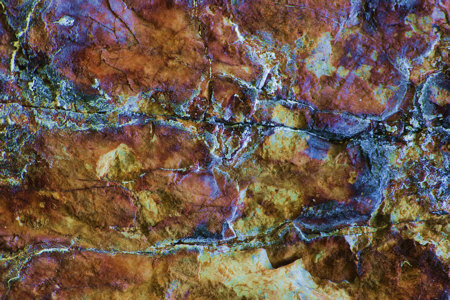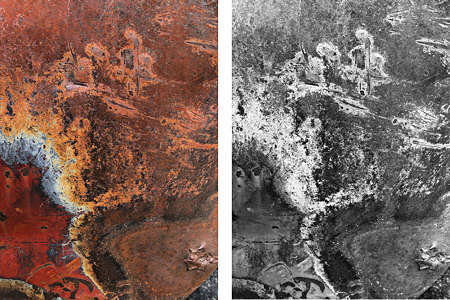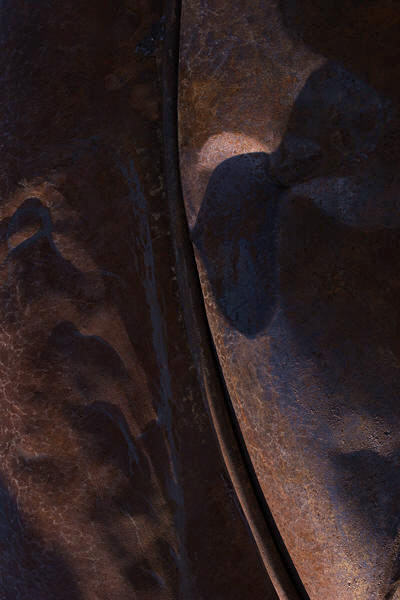Posted by Steve Durbin on February 27th, 2007

Karl asked me last week: What am I trying to say with my Patina photographs of old paint on old cars? Within the context of what I had just been doing — starting to work with strong color and abstract patterns — I quite honestly answered that I didn’t know. But to work with the images, I had to retrieve them from a computer directory “Junkyard cars” that was paired with another one, both under the rubric “Patina-Altered Surfaces.” It wasn’t until browsing later that I was reminded of that second directory called “Rocks.”
more… »
Posted by Richard Rothstein on February 25th, 2007
img src=http://rjr10036.typepad.com/proceed_at_your_own_risk/images/mondrian.jpg alt=”” align=”middle” />
An admirer of my photography recently praised my clever ability to capture the spirit of the great Dutch painter Piet Mondrian in my work. I was quite taken aback by this and without diminishing the genius of Mondrian, I felt obliged to explain to my admirer that he was putting the proverbial cart before the horse. The only relationship I can claim to Mondrian is that our work benefits from the same model, the same muse.
In one sense, Mondrian did not create Broadway Boogie Woogie, rather the boogie woogie of Broadway inspired Mondrian. Mondrian recorded and interpreted with his brush what I record and interpret with my camera: a unique energy fueled by verticals, horizontals and colors that is the visual signature of Manhattan and it’s relentless boogie woogie.

As a young man off on his first world adventures I was stunned by the revelation that many of the great artists I admired did not invent their mysterious landscapes, colors and visual signatures of China, Japan, Tuscany and Provence. Rather they were brilliantly capturing the unique moods, colors, light and shapes that nature had already chosen to create. I remember gazing over the hills of Tuscany for the first time and thinking, “Oh! So that’s where Leonardo got that.” And I remember the day I realized the Van Gogh was “photographing” (through his unusual lens) the unique palette and landscapes of Provence.
more… »
Posted by Steve Durbin on February 20th, 2007

Mark’s paintings yesterday inspired me to a flurry of work with the junkyard abstractions that I introduced last week. As I mentioned then, it’s the color as well as the abstraction that I find fascinating. To explore this a little bit systematically, I went through basic preparation of a number of the images to get a sort of baseline treatment. That involves a choice of overall contrast and saturation, and in one case a slight shift in color balance. Later I can investigate more complex possibilities that might involve manipulations of portions of individual images, or variations in the hue-tone relationships.
more… »
Posted by Richard Rothstein on February 18th, 2007
Posted by Doug Plummer on February 13th, 2007

A while ago I got “fan mail” from someone regarding my portfolio of “stick pictures,” a body of work that I make in dense, brushy environments. She wanted some insight into my process, and I thought it would be illustrative to share the exchange here.
“Often I find that pictures of this nature look cluttered and pinched, but yours I find to be exceptionally emotive and contemplative. I was wondering about your mental and emotional approach to shooting these images. Do you focus more on the mental, with respect to composition, or is it something that you feel more so than see?”
My response:
“Thanks for the note. The “stick pictures” is where I do my deep work as a photographer. It is internal, it is visceral, and the question of why that sort of landscape is so compelling to me is not the interesting one. I’m grateful that there is such a rich vein for me to mine and that it has stayed so compelling for so many years.
“Though I’m sure it would be hugely valuable, I don’t meditate, I don’t do yoga, and I don’t have a regular practice to center myself or otherwise quiet the inner voice in my head so that I can pay attention to the moment. I’m actually an anxious fidgeter much of the time, and I’m forgetful and absent minded. Working with the camera, in the landscape, is the closest I get to a meditation practice of any kind, and it probably occupies that role in my life. I do know that, in those complex brushy environments, I am able to let go of the conscious attention to composition and framing and the sense that “now I’m taking a picture.” The pictures find themselves, and I follow. That part of the brain that is a lot smarter than the part that consciously knows what is going on is taking the lead.
“I have, though, been working this way for a couple of decades. The technical part is fluid and unconscious. I also take a lot of bad pictures when I’m out there. A lot of the work is attending to the results of a given shoot, and ferreting out the one shot that exemplifies the coherence of the moment. My method is to post proof prints in a place where I will see them in my peripheral vision for awhile, like my kitchen. Over time I take down the ones that bore me, and I see what survives. It is the spawning salmon method of photography. Most of the roe get eaten. Only a select few grow to adulthood and see the world.”
The link to the portfolio is here. I’ve fixed the code that seemed to keep non-IE users from viewing the page.
Posted by Steve Durbin on February 13th, 2007
Posted by Richard Rothstein on February 11th, 2007
Reflections inspire much of my work, both in my photography and in my writing. I’m much more intrigued by the subject’s reflection than I am by the subject itself.
![Midtown Manhattan]()
Mirrors
My maternal grandmother Luba Abramanova (made Lilly on 1922 Ellis Island) maintained an uncomfortable truce with mirrors and cameras, anything that would reflect her image. Mirrors served an occasionally necessary function and were to be barely tolerated. Shop windows and reflecting pools were easily avoided. Cameras were–in her estimation–nothing more than mirrors that rudely captured a permanent record of the reflection. We’ve all heard stories about primitive tribes and their superstitious notion that cameras can steal the soul. And then of course we have legends of vampires and their inability to even cast a reflection. Jews have no depictions of humans in their art for fear of violating the Ten Commandment’s prohibition against “idolatry”. Narcissus couldn’t free his own gaze from the reflection in the pool and now he lives in flower pots. Medusa, rendered powerless by her own reflection, was easily slain by Perseus. The mirror defeated the Gorgon. Lilly was clearly on to something important.
Other than the customary bathroom cabinet mirror, the only other mirror in Lilly’s home was a huge Venetian smoked glass decorative mirror hanging over her living room couch at an angle rather than flat against the wall. The mirror was unapproachable. Tilting off the wall as it did, it seemed an odd position for such a big and ominous slab of glass and as a child I often wondered when it would come crashing down on the sofa and some foolish shortsighted victim. For that reason, I never sat on the sofa. If all the chairs were taken at a family gathering, I would sit on the floor pretending to be an Indian. Adults would buy that and think it cute.
Occasionally someone would comment on the Venetian mirror’s limited decorative role. Why not hang a painting instead? Between the odd angle, the couch that kept you at a distance from the mirror and the muted lighting in the living room, you really couldn’t see your own reflection in any practical sense. It wasn’t until I was 16 that I realized that the mirror was deliberately angled in that manner so that Lilly could see the dress she was wearing, but not her own face. She had hung the mirror according to her own height so that her reflection was effectively cut off at the head. more… »





